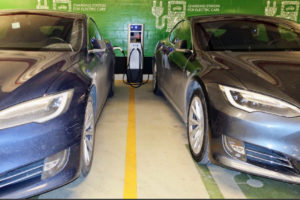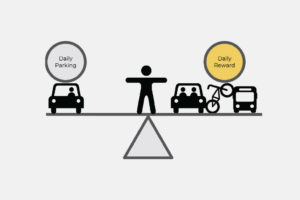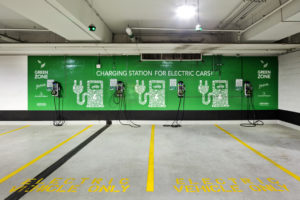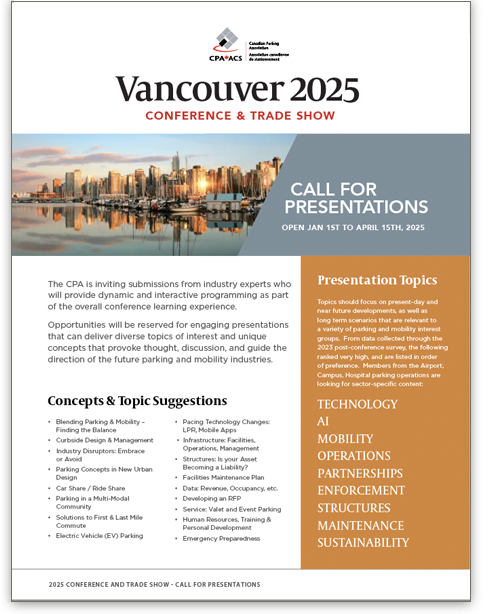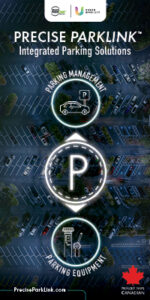I have had a patron ask me what my plans are for facilitating 120 charging for her electric vehicle as it is a simple 120 plug.
What are other institutions doing? I am sure this request will become more and more common.
She said she can use out standard block heater plug ins but is it my obligation to turn those on for people to charge their cars?
Thoughts?
It can be the source of heated arguments and it’s just one of the challenges facing managers of parking garages as electric vehicles become a growing phenomenon in cities across Canada.
“Charging stations are expensive to install, and as electric cars become more prevalent, there are more people clamouring to be able to plug in while they park. We’re having to set up special zones in garages,” says Bradley Jones, head of retail for real estate giant Oxford Properties Group of Toronto.
Oxford has already installed more than 150 charging stations in garages and lots across its Canadian portfolio of offices, retail, industrial and hotel properties. Most are Level 2 plug-ins that run on 240-volt circuits and require several hours to top up an electric vehicle (EV) battery. They can cost as much as $10,000 each to install. A few are fast-charging Level 3 units whose high-voltage circuits can provide up to 64 kilometres of driving range for every 10 minutes of charging but cost between $50,000 and $70,000 each to install. (Level 1 is a connection to a standard 120-volt household current, which can take up to half a day to fully charge an EV battery.)
Many commercial installations in Canada to date have been financed by government grants, but those programs are winding down and now the challenge is to find ways to make providing chargers cost-effective, Mr. Jones says. There’s been resistance to paying extra to plug in. “The tenants balk at paying for the charging when they are…
I’m looking to gather information on Parking Authorities and wanted to reach out to the CPA Community for some assistance. I’m trying to gain an understanding of how they work, the benefits, the drawbacks, comparison with other strategies, etc. Any information would be greatly appreciated.
Thank you in advance.
– Attila Hertel, P.ENG
By Blake Laufer, Founder, MiStall Insight Inc.
I often hear about parking operations lamenting that they are unique. And they are. Very few industries are simultaneously impacted by their physical layout, special interest groups, pricing limitations, weather conditions, political agendas, and technological advancement – all at the same time.
Subsequently, with so many moving parts it’s difficult for parking operations to measure their success. How is my operation doing? Are we profitable? Are we serving our parkers fairly? Am I succeeding as a manager?
We are not alone. Many other industries have similar challenges to parking, and so instead of examining what makes parking different, we should look at how parking is the same. Furthermore, we can learn from other industries how they measure success, and we can adapt those measures to ourselves.
Supply and Demand: It’s the Law
As you’re probably aware, the Law of Supply and Demand works to balance the amount of supply (product available from manufacturers) with demand (amount of product desired by consumers). When prices are higher consumers buy less and manufacturers produce less; when prices are lower consumers buy more and manufacturers produce more.
The Laws of Supply and Demand can be distorted by various factors. One such distortion occurs in the fixed-supply industry where there supply of product is scarce, like parking. In parking the “manufacturer” is the parking operation, and the parking operation cannot easily change the supply of parking spaces in the short-term. (Over the long-term it’s possible to change your supply – build a new garage, for example, but over the short-term we have roughly the same number of parking spaces available to be sold every day.)
Other fixed-supply industries include airlines (with a fixed number…
BY PAULO NUNES-UENO
Parking is out. Mobility is in.
Strolling the vendor booths at the Canadian Parking Association conference in Toronto this year makes that clear. We are all rebranding, it seems. Including me. The group I started at Seattle’s DOT, called the Transit and Mobility Division, manages transit, bikeshare, carshare, and of course, parking. Now as a consultant, I help clients retool their campus and city parking into ‘mobility’ services.
Mobility. Such a sweet word. If you close your eyes, you can almost hear…the future! Unfortunately, the transportation and ecological challenges we face won’t be solved through slogans. And the stakes couldn’t be higher. Get ‘mobility’ right and we stand a chance against climate change. Getting it wrong also spells extinction for those in the parking–I mean mobility–business.
Technology changes and growth make real adaptations all the more urgent. Re-urbanization is transforming cities throughout North America. Companies that a generation ago would have happily sprawled in suburban office parks are packing into downtown skyscrapers. Witness the new Amazon HQs headed to NYC and Washington DC. We can actually see this change happening inside our workplaces. The typical office from the early 2000’s housed 3 or 4 people per 1000 square feet. Today interior designers and architects with open offices and shared workstation have managed to more than double that.
Too bad transportation can’t claim anything close. None of the innovations to date increase the capacity of roadways or parking lots very much.
Driverless cars, the next big ‘innovation’ afoot, will actually make matters worse. Though we don’t know when autonomous vehicles are coming exactly, we can be sure they will impact the urban landscape. How? Because we have experience with services that drop people off at their destination and keep going. They’re called taxis….
By Jennifer Mucha
Toronto Pearson is Canada’s largest airport, and the ninth-busiest airport in North America, moving nearly 50 million annual passengers from security checkpoint to gate to more than 170 destinations around the world. The airport has a mandate to put passengers at the heart of every decision, and as a result was recently recognized by the Airports Council International as the Airport Service Quality best large airport in North America. Believing that the passenger experience starts long before take-off, Toronto Pearson is using technology and analytics to build a diverse and creative transportation offering that ensures travellers have an end-to-end experience tailored to their individual needs, while keeping future aviation demand in its sights.
Toronto Pearson has come a long way from its origins in a farmer’s field in the village of Malton in 1939. The airport grounds now stretch from Mississauga in the west to the city of Toronto in the east and south, and to Brampton in the north. At the heart of three municipalities and close to the 400-series highways, it goes without saying that Toronto Pearson sees high vehicle traffic from passengers, meeters, greeters and employees.
Integrating Parking and Transportation
With nearly 50 million annual passengers, as well as an airport employee community of almost 50,000 workers, efficient transportation into and out of the airport is critical to the success of the operation. An intricate network of municipal transit providers, ground transportation operators and the airport’s own Parking and Ground Transportation business unit work together with a common goal: to ensure that transportation at the airport is integrated, provides a diverse and appropriate range of services and contributes to the airport’s passengers-first mandate.
Achieving that goal is no small feat. Toronto Pearson’s three covered garages and two outdoor lots represent Canada’s…
By Mark Hutchinson, Vice President of Green Building Programs, Canada Green Building Council
The changing nature of the parking and transportation industry has highlighted the importance of understanding the sector’s environmental impact and its key role in mitigating climate change. Among those leading the charge in this area is the Yorkdale Shopping Centre in Toronto’s North York area, which has been no stranger to innovative new initiatives throughout its 50-year history, including a number of sustainability efforts as part of its green program.
In July 2018, the mall achieved Parksmart certification at the Pioneer level for existing parking structures by obtaining more than 90 points for its G Parkade southwest parking garage, and in August, Yorkdale’s newly constructed E Parkade east structure certified Parksmart Bronze by achieving between 110 and 134 points. These are the first Parksmart certified projects in Canada – and the first retail certifications in the world.
The Parksmart rating system is administered in Canada by GBCI Canada, which is jointly-owned by the Canada Green Building Council (CaGBC) and Green Business Certification Inc. (GBCI). Designed to advance sustainable mobility through smarter parking structure design and operation, Parksmart helps parking structure owners and managers ensure their assets are future-proof and functioning optimally in order to maximize operational savings.
For both Yorkdale projects, the Parksmart certification process has served to highlight opportunities to maximize and modernize parking assets, ensure strong returns on investment, and provide an enhanced parking experience for mall patrons.
Redefining parking as part of a broader green strategy
Yorkdale has had green initiatives in place for more than two decades, from being one of the first shopping centres in Canada to implement a recycling program, to more recent measures such as the utilization of reusable tableware and cutlery, organics composting and an urban…
By Chelsea Webster
What affects 1 in 3 Americans, costs trillions of dollars annually, and is a complete mystery to most people?
Why You Should Care About Cybersecurity
There are close to 400 cyber-attacks every single minute in the US, which affect 1 in 3 Americans every single year. It costs companies an average of $15.4 million annually to manage hacks against them, with total annual damage estimated at $6 trillion by 2021.
The point of these stats is not to make you paranoid, but to highlight how real, common, and far reaching cybersecurity threats are. It’s also to get you to take one more step in your thought process and connect cybersecurity to your vehicle – your connected car – knowing that online threats are targeting people everywhere. It should get you thinking about how many cars there are, how big a target market that represents for hackers, and what you can do to protect yourself and your vehicle.
The Connected Car
So, what exactly IS a connected car? A connected car is any vehicle that has wireless connectivity to the Internet and/or other devices, like a satellite or an auto manufacturer or another vehicle or pedestrian. A connected car collects, sends and receives information, processes it, and actions it or alerts the driver to information that requires human action. The image below from the Future of Privacy Forum is a great visual explanation of some of the components.
What Data Does a Car Collect?
Your vehicle is a nosey piece of machinery. It collects external data on traffic, road conditions, signage, markings, weather, and lots more. It also collects a boat load of internal data on you through cameras and microphones. That data can be anything from eye movement to driving habits. The connected car…


